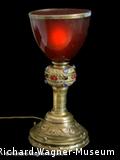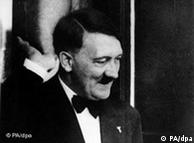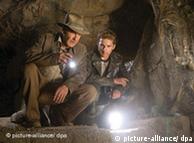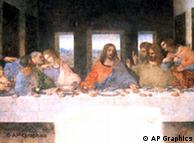Richard Wagner was born on May 22nd 1813. The music for his opera "Tristan and Isolde" was so unusual that, at first, musicians struggled to play it. The singers could not find their notes and the orchestra struggled to keep time. When the musicians did catch up, critics said that it was "nothing but screaming and shrieking"
chalice:(1) 聖爵:行祭使用的聖爵,裡面的葡萄酒經祝聖後成為基督的血。(2) 苦爵:象徵耶穌的苦難(瑪廿六42;若十八11)。拉丁文稱作 calix。
Arts | 13.08.2008
Bayreuth Exhibition Traces Myths of Parsifal's Grail
Parsifal's search for the mythical Grail is not just a topic for Wagner operas. The legend has inspired artists and musicians in many cultures, as a Bayreuth exhibit explores.
When Bayern Munich goalkeeper Oliver Khan raised the German Soccer Cup trophy recently, he also celebrated an ancient myth. The trophy, formed like a golden chalice, reflects the legendary Holy Grail and the triumph of the young hero Parsifal.
"The Holy Grail is sort of a universal symbol in European history," said curator Sven Friedrich, director of the Richard Wagner Museum where the grail exhibit is currently on display. "The chalice is an archetypical symbol of longing and redemption that is still triggering people's imagination."
 Bildunterschrift: Großansicht des Bildes mit der Bildunterschrift: A modern Parsifal in the sports arena
Bildunterschrift: Großansicht des Bildes mit der Bildunterschrift: A modern Parsifal in the sports arena
The most famous version of the Parsifal story is probably Richard Wagner’s opera which premiered in Bayreuth in 1882. In the story, the grail gives life and sustenance to the brotherhood of grail knights.
Wagner based his version on a 12th century story by Chretien de Troyes and Wolfram von Eschenbach's "Parzival" written in 1210. Wagner's opera became so successful that it gave rise to a worldwide boom in grail symbols.
The magic chalice
The Bayreuth exhibition traces the many different versions and sources of the grail myth. The mythical chalice -- in some versions it takes the form of the stone of the Wise Men that can work miracles -- can be found in many cultures, including Indian, Arabic or Celtic legends. In the Celtic Artus saga, the knight Parsifal sets out to search for the grail to find redemption.
 Bildunterschrift: Großansicht des Bildes mit der Bildunterschrift: Grail opera requisite from Bayreuth
Bildunterschrift: Großansicht des Bildes mit der Bildunterschrift: Grail opera requisite from Bayreuth
In Christianity, the grail is seen as the cup that Jesus Christ drank from at the Last Supper. During the crucifixion, it was used to store his blood, hence the idea that the Holy Grail bestows magical forces and eternal life to those who drink from it.
Young Parsifal in Richard Wagner's opera is rather naive. "He has a long way to go in his quest for wisdom, reflecting a deep human need," said Sven Friedrich. In different times, this quest has been interpreted in a variety of contexts.
Of course, the show also features a section on Wagner and Wagnerism, with the composer seen as a modern prophet and festival visitors on a sort of pilgrimage.
Nazis employ Wagner saga
 Bildunterschrift: Großansicht des Bildes mit der Bildunterschrift: Hitler was a frequent visitor to Bayreuth
Bildunterschrift: Großansicht des Bildes mit der Bildunterschrift: Hitler was a frequent visitor to Bayreuth
The National Socialists used the ancient myth for political purposes. To the Nazis, the grail legend symbolized the idea of a pure Germanic identity and redemption by means of racial exclusion.
Model plans for a "grail temple" planned by the Nazis at Wewelsburg, which are on display in the exhibit, reveal how the Nazi ideology perverted the symbol of the grail.
"Mankind hasn't changed much in the very basic facts," said Friedrich, "and of course, even if we don’t know, we are looking for the grail in our times too."
Indiana Jones as Modern Parsifal
 Bildunterschrift: Großansicht des Bildes mit der Bildunterschrift: Harrison Ford searches for grails and other magic gadgets in the Indiana Jones Filmes
Bildunterschrift: Großansicht des Bildes mit der Bildunterschrift: Harrison Ford searches for grails and other magic gadgets in the Indiana Jones Filmes
George Lucas' Indiana Jones films present just one version of a modern Parsifal. And the many books, films and computer games where the grail is a subject show that the legend is very much alive today.
Friedrich said he thinks the saga answers a human need. "In this time of secularism, everyone seems to be looking for an individual, personal religion," Friedrich said. "Every individual puts together various symbols and myths to form a very special, individual sort of religiosity."
"Who is the grail?" is the question asked by the young hero Parsifal in the Wagner opera before he sets out on his long journey. That is also the title of the exhibition.
One universal answer is offered at the end of the exhibit: the visitor peers over a stone wall into a well, and sees -- his own reflection. Clearly, a symbol like the golden chalice can be an aid in the quest for the inner self.
"The Holy Grail is sort of a universal symbol in European history," said curator Sven Friedrich, director of the Richard Wagner Museum where the grail exhibit is currently on display. "The chalice is an archetypical symbol of longing and redemption that is still triggering people's imagination."
 Bildunterschrift: Großansicht des Bildes mit der Bildunterschrift: A modern Parsifal in the sports arena
Bildunterschrift: Großansicht des Bildes mit der Bildunterschrift: A modern Parsifal in the sports arena The most famous version of the Parsifal story is probably Richard Wagner’s opera which premiered in Bayreuth in 1882. In the story, the grail gives life and sustenance to the brotherhood of grail knights.
Wagner based his version on a 12th century story by Chretien de Troyes and Wolfram von Eschenbach's "Parzival" written in 1210. Wagner's opera became so successful that it gave rise to a worldwide boom in grail symbols.
The magic chalice
The Bayreuth exhibition traces the many different versions and sources of the grail myth. The mythical chalice -- in some versions it takes the form of the stone of the Wise Men that can work miracles -- can be found in many cultures, including Indian, Arabic or Celtic legends. In the Celtic Artus saga, the knight Parsifal sets out to search for the grail to find redemption.
 Bildunterschrift: Großansicht des Bildes mit der Bildunterschrift: Grail opera requisite from Bayreuth
Bildunterschrift: Großansicht des Bildes mit der Bildunterschrift: Grail opera requisite from Bayreuth In Christianity, the grail is seen as the cup that Jesus Christ drank from at the Last Supper. During the crucifixion, it was used to store his blood, hence the idea that the Holy Grail bestows magical forces and eternal life to those who drink from it.
Young Parsifal in Richard Wagner's opera is rather naive. "He has a long way to go in his quest for wisdom, reflecting a deep human need," said Sven Friedrich. In different times, this quest has been interpreted in a variety of contexts.
Of course, the show also features a section on Wagner and Wagnerism, with the composer seen as a modern prophet and festival visitors on a sort of pilgrimage.
Nazis employ Wagner saga
 Bildunterschrift: Großansicht des Bildes mit der Bildunterschrift: Hitler was a frequent visitor to Bayreuth
Bildunterschrift: Großansicht des Bildes mit der Bildunterschrift: Hitler was a frequent visitor to Bayreuth The National Socialists used the ancient myth for political purposes. To the Nazis, the grail legend symbolized the idea of a pure Germanic identity and redemption by means of racial exclusion.
Model plans for a "grail temple" planned by the Nazis at Wewelsburg, which are on display in the exhibit, reveal how the Nazi ideology perverted the symbol of the grail.
"Mankind hasn't changed much in the very basic facts," said Friedrich, "and of course, even if we don’t know, we are looking for the grail in our times too."
Indiana Jones as Modern Parsifal
 Bildunterschrift: Großansicht des Bildes mit der Bildunterschrift: Harrison Ford searches for grails and other magic gadgets in the Indiana Jones Filmes
Bildunterschrift: Großansicht des Bildes mit der Bildunterschrift: Harrison Ford searches for grails and other magic gadgets in the Indiana Jones Filmes George Lucas' Indiana Jones films present just one version of a modern Parsifal. And the many books, films and computer games where the grail is a subject show that the legend is very much alive today.
Friedrich said he thinks the saga answers a human need. "In this time of secularism, everyone seems to be looking for an individual, personal religion," Friedrich said. "Every individual puts together various symbols and myths to form a very special, individual sort of religiosity."
"Who is the grail?" is the question asked by the young hero Parsifal in the Wagner opera before he sets out on his long journey. That is also the title of the exhibition.
One universal answer is offered at the end of the exhibit: the visitor peers over a stone wall into a well, and sees -- his own reflection. Clearly, a symbol like the golden chalice can be an aid in the quest for the inner self.
The exhibition at Bayreuth's Margrave Opera House is open daily from 9 am to 6 pm and runs through Aug. 31. For more information, click on the link below.


沒有留言:
張貼留言